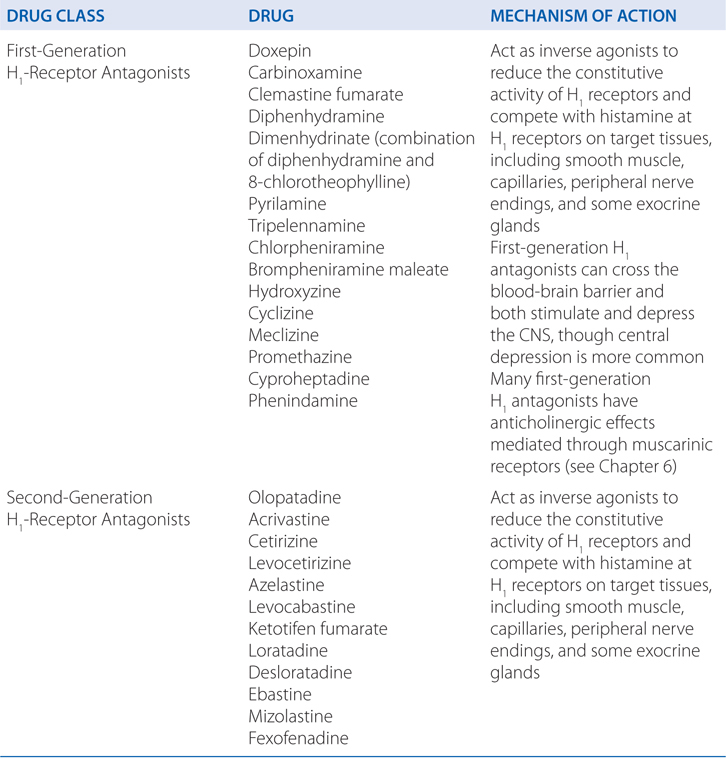21
Histamine, Bradykinin, and Their Antagonists
This chapter will be most useful after having a basic understanding of the material in Chapter 32, Histamine, Bradykinin, and Their Antagonists in Goodman & Gilman’s The Pharmacological Basis of Therapeutics, 12th Edition. In addition to the material presented here, the 12th Edition contains:
• Table 32-1 Characteristics of Histamine Receptors, which shows the biochemical properties, tissue distribution, and representative agonists and antagonists of the 4 histamine receptors (H1, H2, H3, and H4)
• Table 32-2 Preparations and Dosage of Representative H1-Receptor Antagonists
• The molecular structures of histamine and drugs that are agonists and antagonists of the various histamine receptors
LEARNING OBJECTIVES
 Understand the role of histamine and bradykinin in different physiological and pathophysiological processes.
Understand the role of histamine and bradykinin in different physiological and pathophysiological processes.
 Understand the mechanisms of action of drugs that act as antagonists of the H1 receptor.
Understand the mechanisms of action of drugs that act as antagonists of the H1 receptor.
 Know the therapeutic utility of H1-receptor antagonists, alone and in combination with other agents.
Know the therapeutic utility of H1-receptor antagonists, alone and in combination with other agents.
 Know the important adverse effects of H1-receptor antagonists, and the difference between first- and second-generation H1 antihistamines with regard to adverse effects.
Know the important adverse effects of H1-receptor antagonists, and the difference between first- and second-generation H1 antihistamines with regard to adverse effects.
DRUGS INCLUDED IN THIS CHAPTER
• Acrivastine (SEMPREX-D*)
• Aprotinin (TRAYSYLOL)
• Azelastine (ASTELIN)
• Brompheniramine maleate (BROMPHEN, others)
• Carbinoxamine (RONDEC*, others)
• Cetirizine (ZYRTEC)
• Chlorpheniramine (CHLOR-TRIMETON, others)
• Clemastine fumarate (TAVIST, others)
• Cyclizine (MAREZINE)
• Cyproheptadine (PERIACTIN)
• Desloratadine (CLARINEX, AERIUS)
• Dimenhydrinate (combination of diphenhydramine and 8-chlorotheophylline; DRAMAMINE, others)
• Diphenhydramine (BENADRYL, others)
• Doxepin (SINEQUAN)
• Ebastine (EBASTEL)
• Fexofenadine (ALLEGRA, TELFAST)
• Hydroxyzine (ATARAX, others)
• Hydroxyzine (VISTARIL)
• Icatibant (FIRAZYR)
• Ketotifen fumarate (ZADITOR)
• Levocabastine (LIVOSTIN)
• Levocetirizine (XYZAL)
• Loratadine (CLARITIN)
• Meclizine (ANTIVERT, others)
• Mizolastine (MIZOLLEN)
• Olopatadine (PATANOL, PATANASE, others)
• Phenindamine (NOLAHIST)
• Promethazine (PHENERGAN, others)
• Pyrilamine (POLY–HISTINE-D*)
• Tripelennamine (PBZ)
* Trade-name drug that contains other medications.
MECHANISMS OF ACTION OF HISTAMINE RECEPTOR AND BRADYKININ ANTAGONISTS

TRIPLE RESPONSE OF LEWIS
Intradermal injection of histamine elicits a characteristic phenomenon known as the triple response first described in 1927 by Lewis. The triple response consists of:
• A localized red spot extending for a few millimeters around the site of injection that appears within a few seconds and reaches a maximum in ~1 minute
▶ The initial red spot results from the direct vasodilatory effect of histamine (H1 receptor–mediated NO production)
• A brighter red flush, or “flare,” extending ~1 cm beyond the original red spot and developing more slowly
▶ The flare is due to histamine-induced stimulation of axon reflexes that cause indirect vasodilation
• A wheal that is discernible in 1 to 2 minutes and occupies the same area as the original small red spot at the injection site
▶ The wheal reflects histamine’s capacity to increase capillary permeability (edema formation)
FIRST-GENERATION VERSUS SECOND-GENERATION H1 ANTIHISTAMINES
• Side effects are most prominent with first-generation H1 antihistamines, which cross the blood-brain barrier and cause sedation.
• Some of the first-generation H1-receptor antagonists also have anticholinergic properties that can be responsible for symptoms such as dryness of the mouth and respiratory passages, urinary retention or frequency, and dysuria (see Chapter 6).
• The significant sedative effects of some first-generation antihistamines have led to their use in treating insomnia, although better drugs are available (see Chapter 9).
• Some first-generation H1 antagonists (eg, dimenhydrinate, cyclizine, meclizine, and promethazine) can prevent motion sickness, although scopolamine is more effective.
▶ Antiemetic effects of these H1 antihistamines can be beneficial in treating vertigo or postoperative emesis.
• Many H1 antihistamines (both first and second generation) are metabolized by CYPs; thus, inhibitors of CYP activity can increase H1 antihistamine levels, leading to toxicity.
• Certain H1 antihistamines, especially first-generation drugs, are possible teratogens or cause symptomatic effects in infants resulting from secretion of the drug into breast milk.
▶ Cetirizine and loratadine are preferred in pregnant women if H1 antihistamines are required, but if they are not effective, diphenhydramine can be used safely in pregnant (but not breast-feeding) women.
A 24-year-old woman has seasonal allergies in the summer due to various pollens and grasses. Her symptoms include a runny nose and itchy, watery eyes. At the beginning of the summer she takes over-the-counter (OTC) diphenhydramine for relief of symptoms.
a. What is the mechanism of action of diphenhydramine in treating this patient’s symptoms?
Diphenhydramine is a first-generation H1-receptor antagonist. H1 antagonists are most useful in acute types of allergy that present with symptoms of rhinitis, urticaria, and conjunctivitis. Their effect is confined to the suppression of symptoms attributable to the histamine released by the antigen-antibody reaction. These drugs relieve the sneezing, rhinorrhea, and itching of eyes, nose, and throat. A gratifying response is obtained in most patients, especially at the beginning of the season when pollen counts are low; however, the drugs are less effective when the allergens are most abundant, when exposure to them is prolonged, and when nasal congestion is prominent.
b. She finds the diphenhydramine causes her to be drowsy. Why does this agent cause drowsiness?
The first-generation H1 antagonists can cross the blood-brain barrier and can both stimulate and depress the CNS. The most frequent side effect in first-generation H1 antagonists is sedation and usually accompanies therapeutic doses of the older H1
Stay updated, free articles. Join our Telegram channel

Full access? Get Clinical Tree



